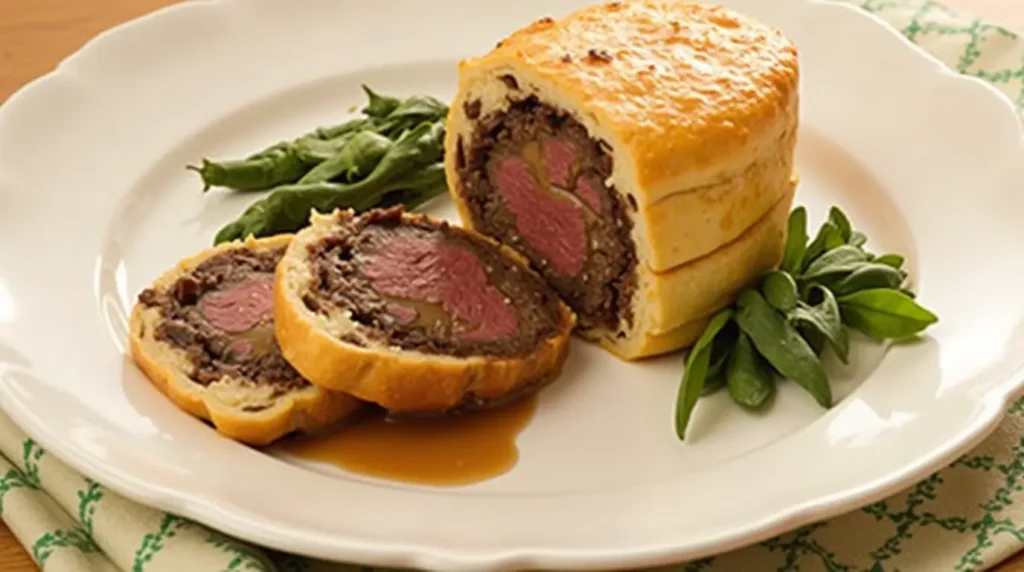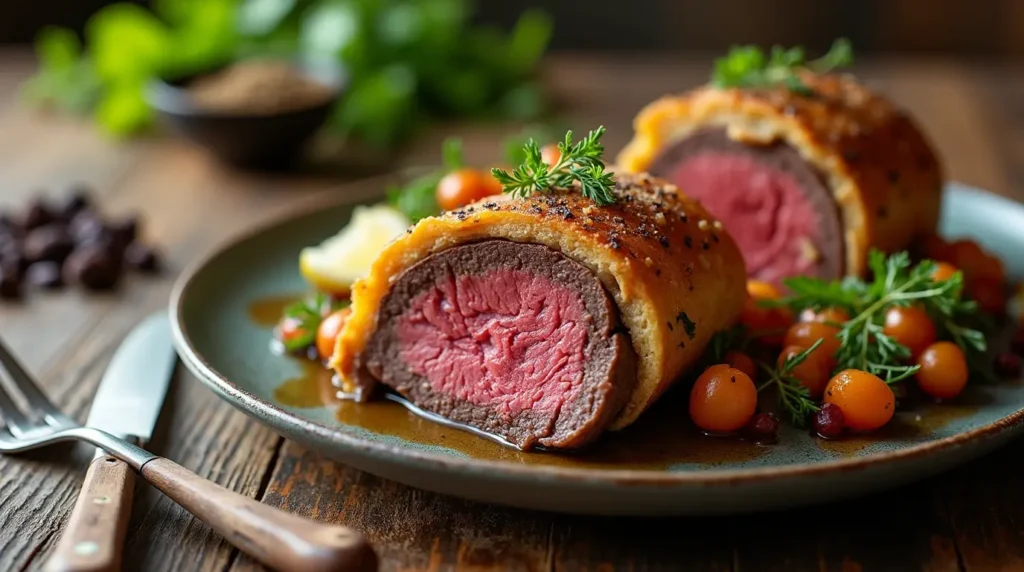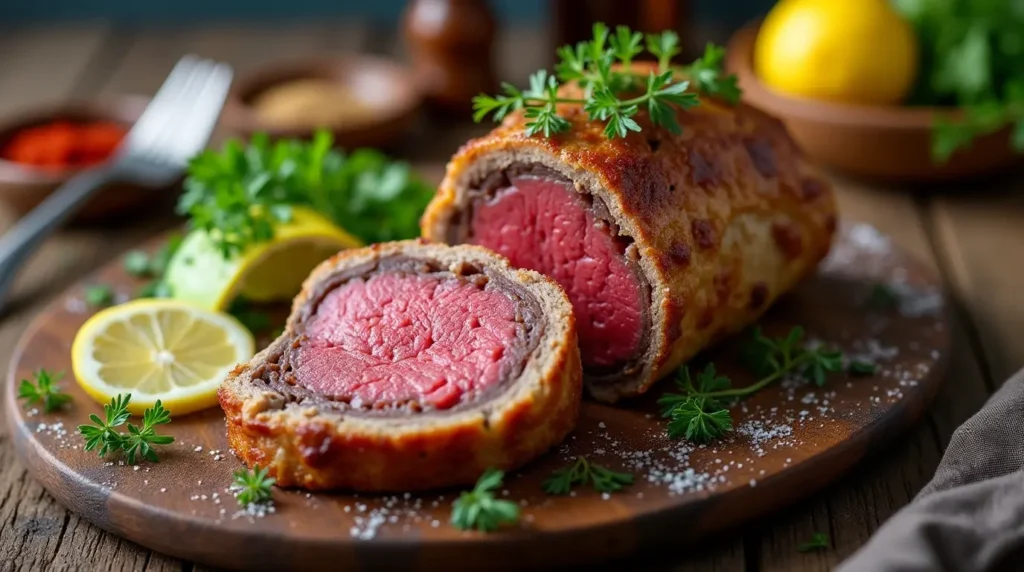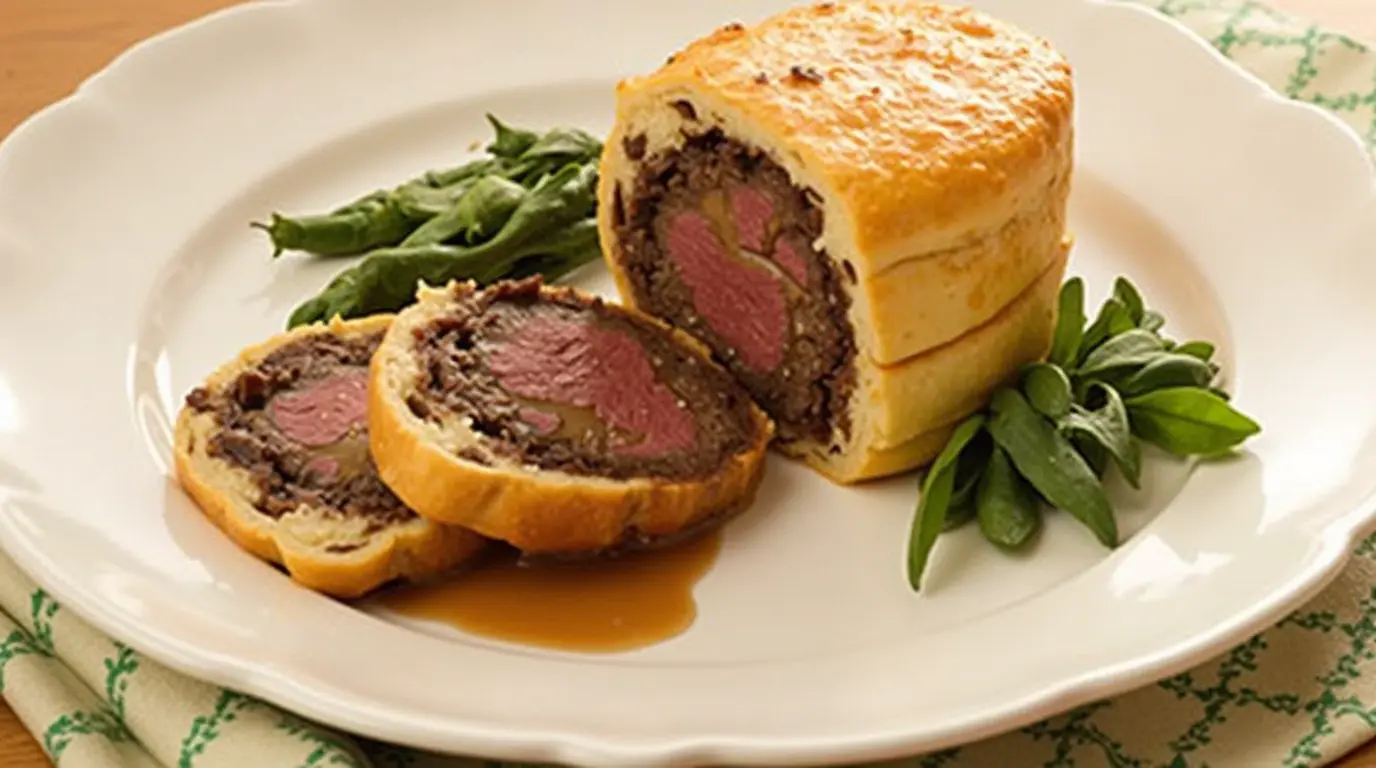Beef Wellington is more than just a dish—it’s an experience. A golden, flaky crust wrapped around a perfectly cooked piece of beef, complemented by savory mushrooms, pâté, and delicate prosciutto. Whether you’re celebrating a special occasion or simply want to treat yourself and your loved ones to a culinary masterpiece, Beef Wellington is a dish that has the power to turn any meal into a memorable one. But for many home cooks, the thought of preparing such an elaborate recipe can be intimidating. What if we told you that with a little patience and guidance, you could master this classic and create something truly spectacular in your own kitchen?
In this article, we will guide you through every step of creating Beef Wellington, from selecting the right cuts of meat to achieving that perfect golden crust. By the end of this guide, you’ll not only be able to prepare a Beef Wellington that looks as good as it tastes but will also have the confidence to make this impressive dish your own.

Table of Contents
Essential Ingredients for the Perfect Beef Wellington
The success of a Beef Wellington lies in the quality and balance of its ingredients. Each element plays a crucial role in achieving the ideal combination of flavors and textures. Let’s break down each essential ingredient and explain why it’s integral to this exquisite dish.
Beef Tenderloin: The Star of the Dish
The beef tenderloin is the most important element of the Wellington. Known for its tenderness and mild flavor, it’s the cut of beef that will deliver the ultimate melt-in-your-mouth experience. Here’s why it’s preferred:
- Texture: Beef tenderloin is lean, with little connective tissue, which makes it extremely tender. It’s perfect for a dish where you want a precise level of doneness and a delicate texture that contrasts beautifully with the crisp pastry and savory duxelles.
- Flavor: While beef tenderloin doesn’t have the strong, beefy flavor of other cuts like ribeye, its subtle flavor works wonderfully with the richness of the other components in the Wellington.
- Ease of Cooking: This cut can be quickly seared to lock in its juices and then easily baked to your desired level of doneness without becoming tough or chewy.
To ensure the best result, choose a 2-3 lb trimmed beef tenderloin. Ask your butcher to tie it with kitchen twine for uniform cooking. If you’re buying it pre-trimmed, it should be completely free of any silver skin or excess fat.
Mushroom Duxelles: Adding Depth of Flavor
The mushroom duxelles is a finely chopped mushroom mixture that infuses the Wellington with earthy, umami-rich flavor. It’s essential for creating a harmonious flavor profile and a moist filling that complements the beef.
- Flavor Profile: Duxelles is made by sautéing mushrooms, often with onions or shallots, and sometimes a splash of white wine or brandy. This technique concentrates the flavor of the mushrooms, creating a deeply savory filling that balances the richness of the beef.
- Texture: The finely chopped mushrooms help to create a cohesive, spreadable paste that holds together well when wrapped in pastry. This filling provides a contrast to the tender beef and flaky pastry.
Common mushrooms used for duxelles include button or cremini mushrooms, but other varieties like shiitake or portobello can also be used for deeper flavor.
To make the perfect duxelles, aim for about 1 lb of mushrooms finely chopped or pulsed in a food processor. Sauté them until all moisture has evaporated and the mixture becomes a dry paste. This helps prevent the pastry from becoming soggy.
Pâté or Foie Gras: Optional, But Elevates the Dish
While not a mandatory ingredient, pâté or foie gras is an indulgent addition that can take your Beef Wellington to the next level. These rich, luxurious elements contribute both flavor and texture, providing an extra layer of decadence.
- Pâté: Pâté is a smooth, seasoned meat paste, often made with liver or other rich cuts of meat. When spread over the seared beef before wrapping, it acts as a flavorful barrier between the meat and the mushroom duxelles, adding richness and complexity.
- Foie Gras: For an extra level of opulence, foie gras can be used instead of pâté. This prized ingredient adds a velvety smoothness and a deeply savory flavor that beautifully complements the beef’s natural tenderness.
If using 2 tbsp of pâté or foie gras, make sure to spread it evenly over the beef before layering the mushrooms and wrapping it in pastry. It should complement the other flavors without overpowering them.
Puff Pastry: The Flaky Golden Crust
The puff pastry is the signature exterior of Beef Wellington, offering a delicate, buttery, and crispy contrast to the rich filling inside. Here’s why it’s so crucial:
- Texture: Puff pastry is made by layering dough and butter, creating thin, flaky layers that puff up when baked. This results in a crisp, golden crust that’s perfect for encasing the tender beef and mushroom filling.
- Flavor: The buttery flavor of puff pastry works in harmony with the richness of the beef and duxelles, providing a satisfying contrast to the savory elements inside.
For the best results, opt for high-quality store-bought puff pastry that’s been properly chilled. Homemade puff pastry can be used for a more personalized touch, but it requires more time and effort. You’ll need one sheet of puff pastry large enough to wrap the entire beef tenderloin.
Prosciutto or Parma Ham: Flavor and Structure
Prosciutto or Parma ham adds both flavor and structure to your Beef Wellington. This thin, cured ham serves two purposes:
- Flavor: The salty, savory taste of prosciutto perfectly balances the richness of the beef and duxelles, while adding a slight sweetness to complement the mushrooms.
- Structure: Prosciutto helps hold the mushroom duxelles in place and provides a layer of protection to prevent the beef from becoming too moist. This helps keep the pastry from getting soggy while ensuring the beef stays juicy.
Use 8-10 slices of thinly sliced prosciutto to completely wrap the beef, covering it with a layer that will hold everything together. Parma ham can also be used as a substitute for prosciutto if you prefer a slightly less salty flavor.
Seasonings: The Essentials
Seasoning is crucial in bringing out the best in all the components of Beef Wellington. The right balance of flavors can elevate the dish without overpowering the natural taste of the beef.
- Salt and Pepper: These basic seasonings are essential for enhancing the natural flavors of the beef, duxelles, and pastry. Don’t skip seasoning the beef before searing it, as well as the duxelles mixture.
- Fresh Thyme: Thyme adds a subtle herbal note that pairs beautifully with beef. You can use fresh thyme both in the duxelles and to season the beef before searing it. The herb’s aromatic quality complements the richness of the dish without being too overpowering.
A couple of tablespoons of fresh thyme will provide just the right touch of herbaceous flavor throughout the dish.
Egg Wash: A Golden, Glossy Finish
The egg wash is a crucial step to achieving a perfect, golden, and glossy finish on your Beef Wellington. Brushing the pastry with an egg wash before baking ensures that the crust will develop a crisp, shiny appearance and a delicious flavor.
- Purpose: The egg wash not only gives the pastry a beautiful golden hue, but it also contributes to the crisp texture of the crust. The fat from the egg helps seal the pastry and prevents any excess moisture from seeping in, ensuring that the Wellington holds its shape.
- How to Apply: Beat one egg and brush it evenly over the surface of the puff pastry before baking. For extra shine, you can brush the Wellington with a second layer of egg wash halfway through baking.
Table: Ingredients for Beef Wellington
| Ingredient | Amount | Notes |
|---|---|---|
| Beef Tenderloin | 2-3 lbs | Trimmed, tied (or ask butcher to do it) |
| Mushrooms | 1 lb | Finely chopped (button or cremini) |
| Prosciutto | 8-10 slices | Thinly sliced |
| Pâté | 2 tbsp | Optional, or substitute with foie gras |
| Puff Pastry | 1 sheet | Enough to wrap the beef completely |
| Egg | 1 | For egg wash |
| Fresh Thyme | 2 tbsp | For seasoning |
Each of these ingredients plays a key role in achieving the perfect Beef Wellington. By using high-quality components and preparing them properly, you’ll ensure that your dish is as flavorful, tender, and beautiful as possible.

How to Prepare Beef Wellington Step-by-Step
Beef Wellington may seem like an intimidating dish, but with the right steps and careful attention to detail, you can create a show-stopping meal that is both visually stunning and incredibly delicious. Below is a step-by-step guide to ensure your Beef Wellington is cooked to perfection.
Step 1 – Searing the Beef
Searing the beef tenderloin is a crucial step that enhances the flavor and texture of the dish. A proper sear locks in the juices, adds a deep umami crust, and helps prevent overcooking during baking.
How to Sear the Beef Properly
- Season Generously – Before searing, season the beef tenderloin liberally with salt and black pepper. This enhances the meat’s natural flavors.
- Use High Heat – Heat a heavy-bottomed skillet (cast iron works best) over high heat until it’s smoking hot.
- Sear All Sides – Add 1-2 tbsp of oil to the pan and sear the beef for about 1-2 minutes per side, including the ends, until a deep brown crust forms.
- Avoid Overcooking – The goal is only to create a crust, not to cook the beef through. The internal temperature should remain low at this stage.
- Cool Completely – Once seared, transfer the beef to a plate and let it cool to room temperature before wrapping. This prevents excess heat from steaming the puff pastry and making it soggy.
Step 2 – Making the Mushroom Duxelles
Mushroom duxelles is a finely chopped and sautéed mushroom mixture that adds a rich umami flavor and prevents excess moisture from making the pastry soggy.
How to Make Mushroom Duxelles
- Finely Chop the Mushrooms – Use a food processor or knife to finely mince 1 lb of mushrooms (button, cremini, or portobello work well).
- Sauté to Remove Moisture – Heat 1 tbsp of butter in a pan over medium heat, then add the mushrooms.
- Cook Until Dry – Stir occasionally and cook for 10-15 minutes, allowing the moisture to evaporate completely. The mixture should be thick and dry.
- Season and Add Aromatics – Add salt, black pepper, and fresh thyme for additional flavor.
- Cool the Mixture – Like the beef, the duxelles should be completely cool before assembling the Wellington.
Why Moisture Control is Important
- Excess liquid will make the puff pastry soggy.
- Cooking the mushrooms thoroughly concentrates their flavor.
- Cooling ensures that the beef remains properly wrapped without affecting the pastry’s structure.
Step 3 – Assembling the Wellington
This step involves layering all components together in a structured manner to create a tight and even wrap.
How to Assemble Beef Wellington
- Prepare the Prosciutto Layer
- Lay a large piece of plastic wrap on a flat surface.
- Arrange 8-10 slices of prosciutto in a slightly overlapping layer.
- Spread the Mushroom Duxelles
- Evenly spread the cooled mushroom duxelles over the prosciutto layer.
- Wrap the Beef
- Place the cooled seared beef tenderloin on top of the mushroom layer.
- Using the plastic wrap, carefully roll the prosciutto and mushroom mixture around the beef, tucking the edges tightly.
- Twist the ends of the plastic wrap to create a firm, compact log.
- Refrigerate for 15-30 minutes to help it hold its shape.
- Wrap in Puff Pastry
- Roll out 1 sheet of puff pastry on a lightly floured surface.
- Unwrap the chilled beef log and place it in the center of the pastry.
- Wrap the pastry tightly around the beef, sealing the edges with a bit of egg wash (beaten egg).
- Trim excess pastry to avoid thick, uneven layers.
- Transfer to a parchment-lined baking sheet, seam side down.
- Decorate and Chill
- Optionally, cut decorative shapes from extra pastry and place them on top.
- Brush the entire pastry with egg wash for a golden, glossy finish.
- Chill for another 15-20 minutes before baking to ensure the pastry holds its shape.
Step 4 – Baking the Beef Wellington
Baking is where everything comes together to achieve the perfect balance of flavors, textures, and doneness.
Oven Temperature and Baking Process
- Preheat the Oven – Set your oven to 400°F (200°C) and place a baking sheet inside to preheat.
- Bake Until Golden Brown – Transfer the chilled Beef Wellington onto the hot baking sheet and bake for 35-45 minutes.
- Check for Doneness – Use an instant-read thermometer to check the internal temperature:
- 120-125°F (49-52°C) for rare
- 130-135°F (54-57°C) for medium-rare
- 140°F+ (60°C+) for medium
How to Achieve a Golden, Flaky Crust
- Brush an even layer of egg wash before baking.
- Bake on a preheated tray for an even, crisp bottom.
- Allow the Wellington to bake undisturbed—no opening the oven frequently.
Step 5 – Resting and Slicing
Resting is crucial to ensure the beef stays juicy.
- Let it Rest – Remove from the oven and let the Beef Wellington rest for 10-15 minutes before slicing. This allows the juices to redistribute.
- Use a Sharp Knife – Slice carefully using a serrated or very sharp knife to prevent crushing the pastry.
- Serve and Enjoy – Plate slices with a side of red wine sauce or a rich beef jus for an elegant finish.
Tips for Perfecting Your Beef Wellington
- Cool Each Layer Before Wrapping
- Let the seared beef and mushroom duxelles cool completely before assembling.
- This prevents steam from softening the puff pastry.
- Chill the Wellington Before Baking
- Refrigerating the assembled Wellington for 15-30 minutes ensures a tighter shape and even cooking.
- Use a Meat Thermometer
- The best way to prevent overcooking is by checking the internal temperature.
- Aim for 120-125°F for rare, 130°F for medium-rare.
- Avoid Overhandling the Pastry
- The more you work with puff pastry, the warmer and softer it becomes.
- Work quickly and keep it cold for the best texture.
- Use High-Quality Ingredients
- Grass-fed beef, fresh mushrooms, and quality prosciutto make a noticeable difference in flavor.
Common Mistakes to Avoid
Making Beef Wellington requires precision and attention to detail. Even a small mistake can affect the overall result, so it’s essential to avoid common pitfalls. Here are some of the most common mistakes and how to avoid them:
Overcooking the Beef: Why Timing and Temperature Are Crucial
One of the most common errors when making Beef Wellington is overcooking the beef tenderloin. The beauty of this dish lies in the tender, juicy beef, and overcooking it can make the meat dry and tough.
- Why It Happens: Overcooking occurs when the beef is left in the oven for too long or at too high a temperature, which can result in the meat losing its natural juices.
- How to Avoid It:
- Use a meat thermometer to ensure you cook the beef to the correct internal temperature (120-125°F for rare, 130°F for medium-rare).
- Sear the beef just long enough to create a crust without cooking it through. The searing process should only take 1-2 minutes per side.
- Allow the Wellington to rest for 10-15 minutes after baking so the juices can redistribute, ensuring the beef stays moist and tender.
By carefully monitoring the temperature, you’ll achieve a beautifully cooked, tender beef center that contrasts perfectly with the flaky pastry.
Soggy Pastry: How to Prevent Moisture Buildup
A soggy crust is one of the most disappointing aspects of Beef Wellington. The combination of the beef’s juices, the mushroom duxelles, and the egg wash can all contribute to sogginess if not handled correctly.
- Why It Happens:
- The mushroom duxelles release moisture as they cook, and if it’s not fully cooked and dried out, it will make the pastry soggy.
- If the beef is too hot when wrapped in pastry, the moisture can also soften the dough, resulting in a wet crust.
- How to Avoid It:
- Dry the mushroom duxelles thoroughly by cooking it until all moisture has evaporated. This will prevent liquid from seeping into the pastry.
- Cool the beef completely after searing before wrapping it in pastry. Hot beef releases steam, which can soften the pastry.
- Chill the assembled Wellington before baking for 15-30 minutes. This helps the pastry stay firm and keeps the structure intact during baking.
- If possible, use a layer of prosciutto to create a barrier that keeps moisture away from the pastry.
By following these tips, you can ensure that your Beef Wellington has a crisp, golden exterior.
Underseasoning: The Importance of Seasoning Each Layer Properly
Seasoning is key to creating a balanced and flavorful Beef Wellington. If you don’t season each layer properly, the dish may end up tasting bland despite the richness of the beef and pastry.
- Why It Happens:
- Sometimes, cooks assume that the layers (especially the duxelles or prosciutto) will provide enough seasoning. However, each component needs its own dose of salt and pepper to build the overall flavor profile.
- How to Avoid It:
- Season the beef generously with salt and pepper before searing it. This ensures the beef itself is flavorful and well-seasoned.
- Season the duxelles with salt, pepper, and fresh herbs like thyme. The mushrooms are a base flavor for the entire Wellington, so make sure they’re well-seasoned.
- Season the prosciutto layer lightly with salt and pepper, as it helps enhance the meat’s flavors without overpowering them.
- Finally, don’t forget to season the egg wash with a pinch of salt to ensure the pastry has a balanced, savory finish.
Beef Wellington Cooking Variations
Beef Wellington is a versatile dish, and with a little creativity, you can modify it to suit different dietary preferences or occasions. Here are some exciting variations:
Vegetarian Wellington: Replacing the Beef with Mushrooms or a Vegetarian Protein Alternative
For vegetarians or those who prefer a plant-based version, a Vegetarian Wellington can be made by replacing the beef with mushrooms or other vegetarian ingredients.
- Mushroom Wellington:
- Use portobello mushrooms or a mixture of wild mushrooms as the base of the Wellington. These mushrooms have a meaty texture and earthy flavor that mimic the richness of beef.
- You can also make a hearty filling by combining mushrooms with spinach, nuts (like walnuts or chestnuts), and cheese for added depth.
- Vegetarian Protein Alternatives:
- Lentils, quinoa, or tofu can be used as protein substitutes. Make sure to season them well and balance the textures with hearty vegetables and nuts to achieve a satisfying dish.
This variation is perfect for guests who don’t eat meat but still want to experience the classic flavors of Beef Wellington.
Mini Wellingtons: Perfect for Parties or Individual Servings
Miniaturizing Beef Wellington makes it an ideal dish for parties, appetizers, or individual servings. These bite-sized versions can be served as elegant hors d’oeuvres or as part of a larger buffet.
- How to Make Mini Wellingtons:
- Use smaller cuts of beef, like filet mignon or beef tenderloin medallions.
- Wrap the beef and duxelles in small squares of puff pastry, just like you would for the full-sized Wellington, but bake them for less time (usually 20-30 minutes).
Mini Wellingtons are perfect for gatherings where you want to impress guests with a single bite of this decadent dish.
Flavored Pastry: How to Add Herbs or Other Flavors to the Pastry
Adding extra flavors to the puff pastry itself can elevate the dish even further. Here are a few ideas to customize the pastry:
- Herbed Pastry: Incorporate fresh herbs such as rosemary, thyme, or sage into the pastry dough. This imparts subtle aromas and flavors that complement the richness of the beef.
- Cheese-Filled Pastry: Add parmesan or gruyère cheese to the pastry for a nutty, cheesy depth. This works well with a mushroom-based Wellington or adds complexity to the traditional beef version.
- Spicy Pastry: For an extra kick, try adding a pinch of cayenne pepper or paprika to the dough to give the Wellington a bit of heat.
By customizing the pastry, you can put your personal spin on the dish while still retaining its traditional charm.
Serving Suggestions for Beef Wellington
Beef Wellington is a rich and luxurious dish, so pairing it with the right sides and beverages is essential to create a well-rounded meal. Here are some ideas for serving and complementing your Beef Wellington:
Side Dishes that Complement Beef Wellington
- Mashed Potatoes
- Creamy mashed potatoes are a classic pairing with Beef Wellington, providing a rich and smooth contrast to the crispy pastry and tender beef.
- Garlic mashed potatoes or those with a touch of butter and cream are ideal.
- Roasted Vegetables
- Roasted carrots, parsnips, and brussels sprouts add earthy flavors that balance the richness of the Wellington. Their natural sweetness complements the savory beef and mushrooms.
- Asparagus or green beans sautéed with garlic and butter also make a great side.
- Simple Green Salad
- A light, refreshing green salad with a tangy vinaigrette helps cut through the richness of the Wellington. Opt for mixed greens, arugula, or baby spinach.
- Red Wine Sauce or Jus
- A rich, silky red wine sauce or beef jus can be drizzled over the Wellington to enhance the beef’s natural flavors and add moisture to the dish.
Wine Pairings: Full-Bodied Reds Like Cabernet Sauvignon, Merlot, or a Bold Bordeaux
Pairing the right wine with Beef Wellington is essential for elevating the meal. The rich, hearty nature of the dish calls for wines with structure and bold flavors:
- Cabernet Sauvignon: This classic red wine has a full-bodied flavor with bold tannins that complement the rich beef and pastry.
- Merlot: A bit softer and fruitier, Merlot offers a smoother pairing with a little less acidity, making it a great match for Beef Wellington.
- Bordeaux: Particularly a left-bank Bordeaux, with its structured tannins and deep flavors of dark fruit and earth, pairs beautifully with the richness of the Wellington.
A good red wine not only complements the flavors of the beef but also enhances the overall dining experience.
Garnishing the Dish with Herbs or a Rich Sauce for Added Flavor
Finish your Beef Wellington with a sprinkle of fresh herbs, such as thyme or parsley, for a bright, fresh contrast to the richness of the dish. A dollop of horseradish cream or a rich gravy can also add an extra layer of flavor and acidity to balance the meal.

Frequently Asked Questions (FAQ)
1. How do I store leftover Beef Wellington?
Leftover Beef Wellington can be stored in the refrigerator for up to 3 days. Wrap it tightly in plastic wrap or foil to preserve its freshness. To reheat, place it in the oven at a low temperature (300°F) to prevent the pastry from becoming too soggy.
2. Can I make Beef Wellington ahead of time?
Yes, you can prepare Beef Wellington up to the point of baking and refrigerate it for up to 24 hours. Be sure to bring it to room temperature before baking. This will ensure the pastry bakes evenly.
3. What is the best cut of beef for Wellington?
The best cut for Beef Wellington is beef tenderloin. It’s tender, lean, and cooks evenly, making it the ideal choice for this dish.
4. How do I achieve the perfect golden crust?
The key to a golden, crispy crust is the egg wash. Brush the pastry with beaten egg before baking, and for an extra crisp finish, bake on a preheated baking sheet.
Conclusion
Beef Wellington is the ultimate dish for making a statement at any gathering, and with the right preparation, it’s a challenge that any home cook can conquer. By following our step-by-step guide, you’ll be able to create a Beef Wellington that looks as impressive as it tastes—without the stress. The combination of perfectly cooked beef, flavorful duxelles, and buttery pastry is bound to leave a lasting impression on your guests, making it the highlight of any celebration. Whether you’re an experienced cook or a beginner, this recipe will make you feel like a true culinary master.


1 thought on “Beef Wellington A Step-by-Step Recipe”